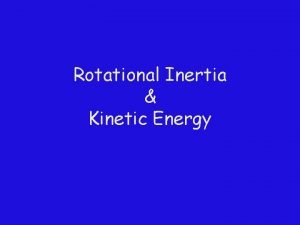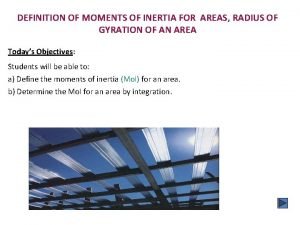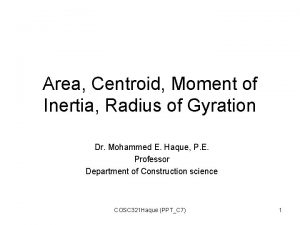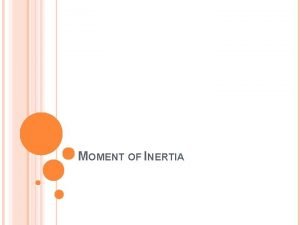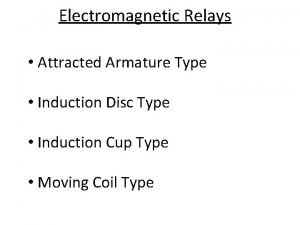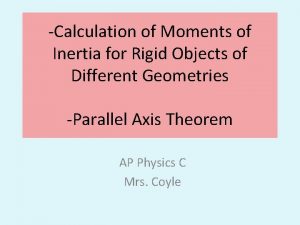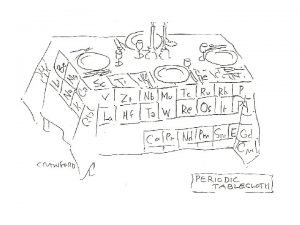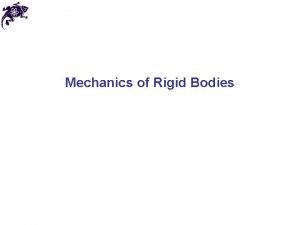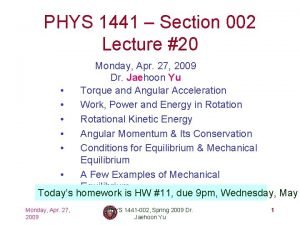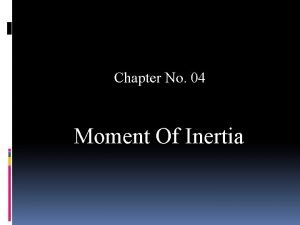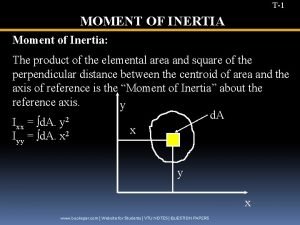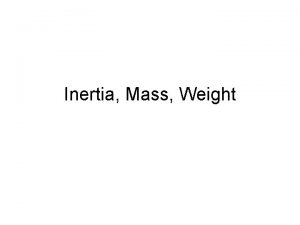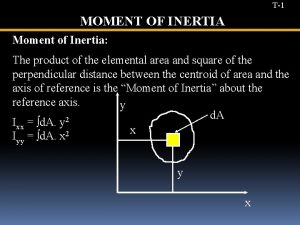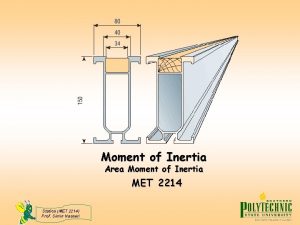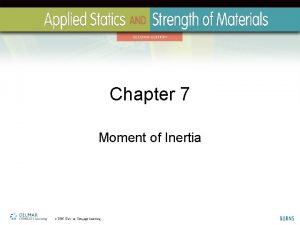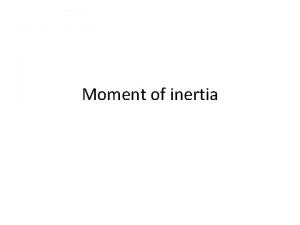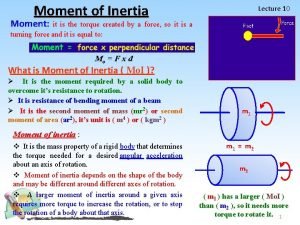Moment of Inertia Lecture 10 Moment it is














- Slides: 14

Moment of Inertia Lecture 10 Moment: it is the torque created by a force, so it is a turning force and it is equal to: Mo = F x d What is Moment of Inertia ( Mo. I )? Ø It is the moment required by a solid body to overcome it’s resistance to rotation. Ø It is resistance of bending moment of a beam Ø It is the second moment of mass (mr 2) or second moment of area (ar 2), it’s unit is ( m 4 ) or ( kgm 2 ) m 1 Moment of inertia : v It is the mass property of a rigid body that determines the torque needed for a desired angular acceleration about an axis of rotation. v Moment of inertia depends on the shape of the body and may be different around different axes of rotation. v A larger moment of inertia around a given axis requires more torque to increase the rotation, or to stop the rotation of a body about that axis. m 1 = m 2 ( m 1 ) has a larger ( Mo. I ) than ( m 2 ), so it needs more torque to rotate it. 1

Moment of Inertia for Area Ø To understand the concept of ( Mo. I ) for Area, lets Consider a plate submerged in a liquid. Ø The pressure of a liquid at a distance z below the surface is given by: Lecture 10 Liquid surface p = . z where: is the specific weight of the liquid. v The force on the area ( d. A ) at that point is: d. F = p. d. A v The moment about the x-axis due to this force is [ z. (d. F) ], the total moment is: A z. d. F = A z. P. d. A = A . z 2. d. A = . A( z 2. d. A ) = . Iwhere: the integral term is referred to as the moment of inertial of the area of the plate about an axis. A( z 2. d. A ) = I = the moment of inertia for area or the second moment for area This sort of integral term also appears in solid mechanics ( strength of material ) when determining stresses and deflection. 2

Moment of Inertia for Area Lecture 10 Ø Consider three different possible cross sectional shapes and areas for the beam ( RS ). Ø All have the same total area and, assuming they are made of same material, they will have the same mass per unit length. v For the given vertical loading ( F ) on the beam, which shape will develop less internal stress and deflection? Why? v The answer depends on the ( Mo. I ) of the beam about the x-axis. v It turns out that Section ( A ) has the highest ( Mo. I ) because most of the area is farthest from the x axis. Ø Hence, it has the least stress ( T ) and deflection : T = M. y/I Ø as ( I ) increases, ( T ) or stress decreases. 3

Moment of Inertia for Area Lecture 10 The Rectangular moments of inertia Ix and Iy of an area are defined as: Ø For the differential area ( d. A ), shown in the figure: d Ix d Iy = = y 2. d. A x 2. d. A The Polar moments of inertia Ix and Iy of an area are defined as: d JO = r 2. d. A = ( x 2 + y 2 ). d. A d JO = x 2. d. A + y 2. d. A d JO = d I x + d I y where: ( JO ) is the polar moment of inertia about the pole ( O ) or ( z axis ). v The moments of inertia for the entire area are obtained by integration. JO Ix = A y 2. d. A ; Iy = A x 2. d. A = A r 2. d. A = A ( x 2 + y 2 ). d. A = Ix + Iy v The ( Mo. I ) is also referred to as the second moment of an area and has units of length to the fourth power (m 4 or in 4). 4

Moment of Inertia for Area Lecture 10 Radius of Gyration: Ø To understand the concept of radius of gyration, suppose that a rigid body is made up of large number of identical particles; each of mass ( m ). Ø Let ( r 1, r 2, r 3…. rn ) be the perpendicular distances of these particles from the axis of rotation as shown in figure. Ø Then the ( Mo. I ) of the body about the axis is given by: rn m Ø Multiplying and dividing by ( n ) of the equation, it becomes: m r 1 O m r 2 r 3 ω m Where: M is the total mass of the body. 5

Moment of Inertia for Area Lecture 10 v The radius of gyration of an area ( A ) with respect to the ( x axis ) is defined as the distance ( kx ). where: Ix = k x. A v With similar definitions for the radii of gyration of ( A ) with respect to the ( y axis ) and with respect to ( O ), we have: Parallel - Axis Theorem for an Area: Ø This theorem relates the moment of inertia (Mo. I) of an area about an axis passing through the area’s centroid to the ( Mo. I ) of the area about a corresponding parallel axis. Ø This theorem has many practical applications, especially when working with composite areas. Ø Consider an area with centroid ( C ). The ( x' and y' ) axes pass through ( C ). 6

Parallel - Axis Theorem for an Area: Lecture 10 v The ( Mo. I ) about the ( x-axis ), which is parallel to, and with distance ( dy ) from the ( x ' axis ), is found by using the parallel-axis theorem. IX = A y 2 d. A = A (y' + dy)2 d. A = A y' 2 d. A + 2 dy A y' d. A + dy 2 A d. A Using the definition of the centroid: y' = y’ + dy ( A y' d. A) / ( A d. A) Now, since ( C ) is at the origin of the ( x' – y‘ axes ): y' = 0 , Thus: and hence, IX = I X ' + A d y 2 A y' d. A = 0 Similarly, IY = I Y ' + A d X 2 Ø The polar moment of inertia ( JO ) of an area about (O ) and the polar moment of inertia ( JC ) of the area about its centroid are related to the distance ( d ) between points (C ) and (O ) by the relationship: JO = JC + Ad 2 Ø The parallel-axis theorem is used very effectively to compute the moment of inertia of a composite area with respect to a given axis. 7

Area Moment of Inertia of Common Shapes: Lecture 10 The following ( Mo. I ) is for common & standard shapes that can be used to determine the ( Mo. I ) for composite area: 8

Lecture 10 Mo. I for an Area by Integration: Ø For simplicity, the area element used has a differential size in only one direction ( dx or dy ). Ø This results in a single integration and is usually simpler than doing a double integration with two differentials ( dx and dy ). The step-by-step procedure is: 1. Choose the element d. A: There are two choices a vertical strip or a horizontal strip. Some considerations about this choice are: x a) The element parallel to the axis about which the ( Mo. I ) is to be determined usually results in an easier solution. For example, it is typically choose a horizontal strip for determining ( Ix ) and a vertical strip for determining ( Iy ). b) If ( y ) is easily expressed in terms of x (e. g. , y = x 2 + 1), then choosing a vertical strip with a differential element ( dx ) wide may be advantageous. 2. Integrate to find the ( Mo. I ). For example, given the element shown in the figure above: Iy = x 2 d. A = x 2 y dx Ix = d Ix = (1 / 3) y 3 dx 9

Examples of ( Mo. I ) for Area: Lecture 10 Example 1 ( by integration ): Find The ( Mo. I ) of the area about the x- and y-axes for the shaded area shown in the figure. Solution Ix y 2 d. A = (4 – x) dy = Ix 0 = (4 – y 2/4) dy y y 2 (4 – y 2/4) dy 4 = [ (4/3) y 3 – (1/20) y 5 ] 0 = 34. 1 in 4 In the above example, it will be difficult to determine ( Iy ) using a horizontal strip, thus it is useful to use vertical strip. Iy = = = x 2 d. A = x 2 y. dx x 2 (2 x) dx 2 0 x 2. 5 dx 4 3. 5 [ (2/3. 5) x ] 0 73. 1 in 4 x However, Ix in this example can be determined using a vertical strip. So: Ix = (1/3) y 3 dx = (1/3) (2 x)3 dx. 10

Example 2 ( by integration ): (a) Determine the centroidal polar moment of inertia of a circular area by direct integration. (b) Using the result of part a, determine the moment of inertia of a circular area with respect to a diameter. Solution Lecture 10 x x 11

Lecture 10 Example 3 ( composite area ): Compute the moment of inertia of the composite area shown in the figure. Solution = 12

Example 4 ( composite area ): Lecture 10 Determine the moments of inertia and the radius of gyration of the shaded area with respect to the x and y axes. Solution 13

Continue Example 4 ( composite area ): Lecture 10 14
 Moment distribution method
Moment distribution method Linear kinetic energy
Linear kinetic energy Slidetodoc.com
Slidetodoc.com Area moment of inertia
Area moment of inertia Type of moment
Type of moment Induction cup type relay
Induction cup type relay Cylinder moment of inertia
Cylinder moment of inertia Moment of inertia of a cube
Moment of inertia of a cube Moment of inertia beam
Moment of inertia beam Moment of inertia addition
Moment of inertia addition What is rigid body
What is rigid body Student exploration: moment of inertia
Student exploration: moment of inertia Thin walled hollow cylinder moment of inertia
Thin walled hollow cylinder moment of inertia Ixx for circle
Ixx for circle Horizontal centroidal axis
Horizontal centroidal axis

